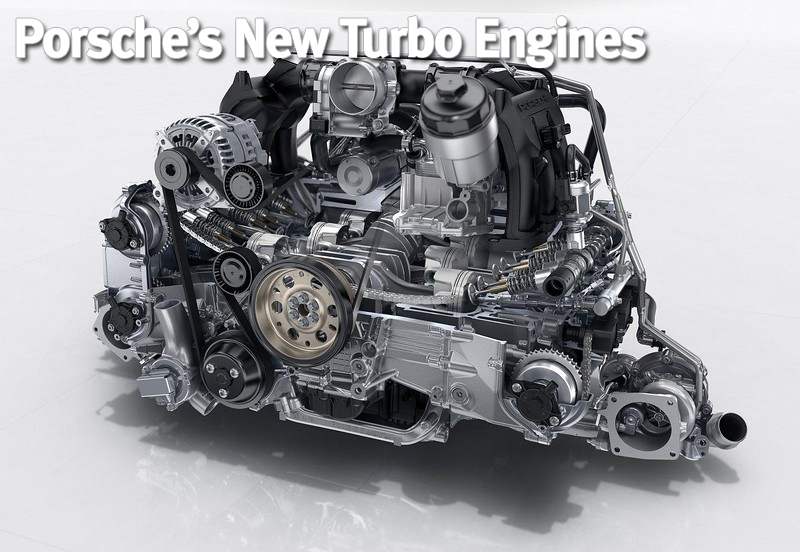Sneak Peek: Porsche’s New Turbo Engines
The industry push towards smaller displacement turbo engines is in full-swing. Across every make and model, large displacement naturally aspirated engines are being replaced by smaller displacement turbo engines in the name of improved fuel economy and reduced emissions. We showed you the why in our engine downsizing article. Companies that had previously ridiculed turbo engines in the 90’s have completely changed course with the prime examples being BMW, Honda, and Ferrari.
 We saw this twin-turbo V6 for the Macan back in 2013.
We saw this twin-turbo V6 for the Macan back in 2013.Each of those companies was known for their exotic and high revving naturally aspirated engines. Now BMW doesn’t have a single naturally aspirated engine in its lineup that I can think of. The last hurrahs of the high revving V8 and V10 in the M3 and M5 have been kicked out from under the bonnet and replaced with turbo inline-6 and V8 engines producing mountains more torque and heaps more power while getting better fuel economy. The main downside is the lack of exhaust note, but BMW tried to make up for that by plumbing fake exhaust noises through the stereo system. Ford does this on the Ecoboost Mustang too. Honda’s new Civic Type-R is getting a 2.0L turbo engine because there’s no way for a 2.0L NA engine to compete with the boosted hot hatches in the form of the VW Golf and Ford Focus. Ferrari went to a downsized twin-turbo V8 in their new 488 and it decimates the older naturally aspirated 458 in all performance criteria.
Porsche has always had feet in both camps of high revving NA engines and high power turbo engines. The heavy hitter boosted engines had previously been reserved for the 911 Turbo and GT2. As we already mentioned, emissions are driving the change to boosted engines in the 911 and Boxster/Cayman platform. However, let’s face it, Porsche was getting embarrassed by their Audi cousins. A new Audi S3 is the equal to the naturally aspirated 911 Carrera in 0-60 while having two extra doors and leaving the owner with about an extra $30k in the trunk. With a quick reflash in the S3, the old 911 Carrera is seeing S3 taillights. That is a pretty embarrassing scenario for Porsche, no?
 Enter the new 3.0L twin-turbo flat-6 engine for the 911 Carrera and Carrera S replacing the old 3.4L and 3.8L naturally aspirated engines. To give the Carrera S a bit more power than the base Carrera, the turbos are fitted with larger compressor wheels (52mm diameter vs. 49mm if my memory serves me correctly). You can see the symmetry of the engine with turbos and intercoolers on each side. You can see the packaging is a bit tight with the intercoolers and turbos.
Enter the new 3.0L twin-turbo flat-6 engine for the 911 Carrera and Carrera S replacing the old 3.4L and 3.8L naturally aspirated engines. To give the Carrera S a bit more power than the base Carrera, the turbos are fitted with larger compressor wheels (52mm diameter vs. 49mm if my memory serves me correctly). You can see the symmetry of the engine with turbos and intercoolers on each side. You can see the packaging is a bit tight with the intercoolers and turbos. I actually saw some pre-production 911s and Boxsters driving around LA. On the 911 Carrera, there were no big side scoops such as on the 911 Turbo to easily give away the turbos hiding underneath. The only clues were the intercooler outlets in the lower rear bumpers and the deeper, less raspy exhaust note.
I actually saw some pre-production 911s and Boxsters driving around LA. On the 911 Carrera, there were no big side scoops such as on the 911 Turbo to easily give away the turbos hiding underneath. The only clues were the intercooler outlets in the lower rear bumpers and the deeper, less raspy exhaust note. So how do the intercoolers get air? Duct work at the base of the air intake vents behind the rear window direct air to the side mounted intercoolers. Then more duct work dumps that air into the low-pressure area behind the rear tires which helps suck the air through the intercoolers.
So how do the intercoolers get air? Duct work at the base of the air intake vents behind the rear window direct air to the side mounted intercoolers. Then more duct work dumps that air into the low-pressure area behind the rear tires which helps suck the air through the intercoolers.



